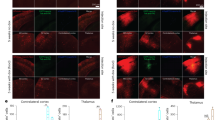Abstract
We have constructed a deletion-mutant rabies virus encoding EGFP and find it to be an excellent tool for studying detailed morphology and physiology of neurons projecting to injection sites within the mammalian brain. The virus cannot spread beyond initially infected cells yet, unlike other viral vectors, replicates its core within them. The cells therefore fluoresce intensely, revealing fine dendritic and axonal structure with no background from partially or faintly labeled cells.


Similar content being viewed by others
References
Katz, L.C. J. Neurosci. 7, 1223–1249 (1987).
Dacey, D.M., Peterson, B.B., Robinson, F.R. & Gamlin, P.D. Neuron 37, 15–27 (2003).
Tamamaki, N., Nakamura, K., Furuta, T., Asamoto, K. & Kaneko, T. Neurosci. Res. 38, 231–236 (2000).
Tomioka, R. & Rockland, K.S. J. Histochem. Cytochem. 54, 539–548 (2006).
Ugolini, G. J. Comp. Neurol. 356, 457–480 (1995).
Mebatsion, T., Konig, M. & Conzelmann, K.K. Cell 84, 941–951 (1996).
Etessami, R. et al. J. Gen. Virol. 81, 2147–2153 (2000).
Mazarakis, N.D. et al. Hum. Mol. Genet. 10, 2109–2121 (2001).
Frampton, A.R. Jr ., Goins, W.F., Nakano, K., Burton, E.A. & Glorioso, J.C. Gene Ther. 12, 891–901 (2005).
Deschenes, M., Veinante, P. & Zhang, Z.W. Brain Res. Brain Res. Rev. 28, 286–308 (1998).
Acknowledgements
We thank M. De La Parra and K. Roby for technical assistance, G. Tiscornia and I. Verma (Salk Institute) for plasmids and assistance with making the lentivirus, and D. Chambers for assistance with confocal microscopy and fluorescence quantification. We also thank L. Enquist (Princeton Univ.) for stocks of pseudorabies virus and S. Young (Salk Institute) for providing adenovirus. The SAD B19 glycoprotein expression plasmid pHCMV-RabiesG was a gift from M. Sena-Esteves (Harvard Medical School). This work was supported by US National Institute of Mental Health grant no. 63912 and Deutsche Forschungsgemeinschaft grant no. SFB455-A3.
Author information
Authors and Affiliations
Corresponding author
Ethics declarations
Competing interests
Generation of non-segmented negative-stranded RNA viruses from cloned DNA, described in this paper, is covered by US patent number 6,033,886, “Recombinant infectious non-segmented negative strand RNA virus,” filed Feb. 28, 1997; inventor: K.K.C.
Supplementary information
Supplementary Fig. 1
High EGFP expression reveals fine structural details of infected cells without immunohistochemical amplification.
Supplementary Fig. 2
Survival time course of neurons infected with SADΔG-EGFP.
Rights and permissions
About this article
Cite this article
Wickersham, I., Finke, S., Conzelmann, KK. et al. Retrograde neuronal tracing with a deletion-mutant rabies virus. Nat Methods 4, 47–49 (2007). https://doi.org/10.1038/nmeth999
Received:
Accepted:
Published:
Issue Date:
DOI: https://doi.org/10.1038/nmeth999
- Springer Nature America, Inc.
This article is cited by
-
Long-term labeling and imaging of synaptically connected neuronal networks in vivo using double-deletion-mutant rabies viruses
Nature Neuroscience (2024)
-
Imaging brain tissue architecture across millimeter to nanometer scales
Nature Biotechnology (2023)
-
Brain imaging turned inside out
Nature Biotechnology (2023)
-
Dense 4D nanoscale reconstruction of living brain tissue
Nature Methods (2023)
-
Linking connectome with transcriptome using a self-inactivating rabies virus
Nature Methods (2023)





